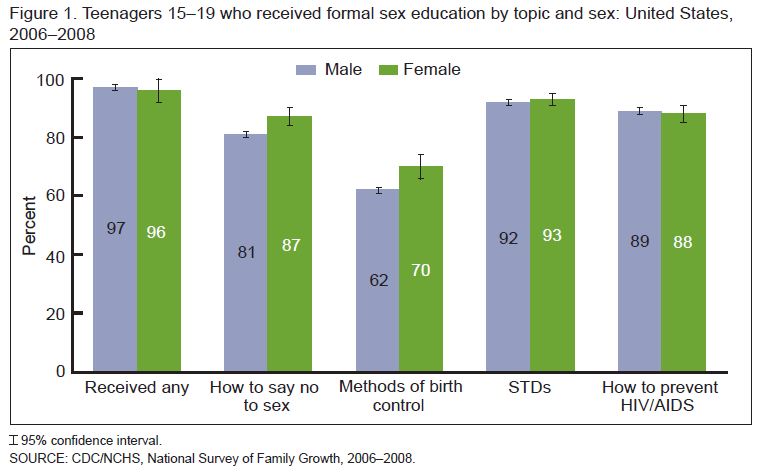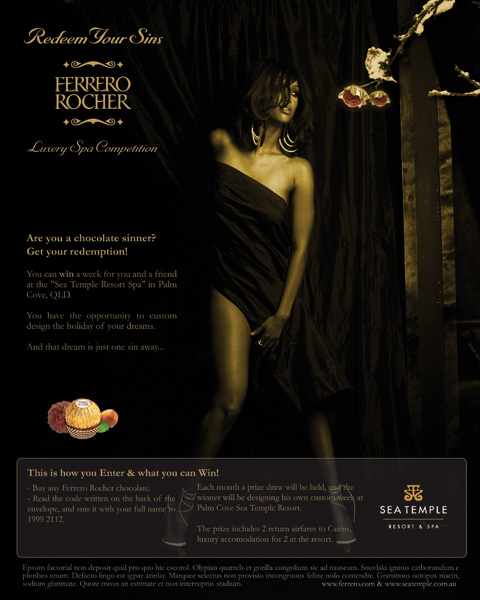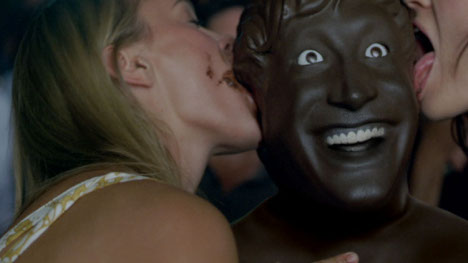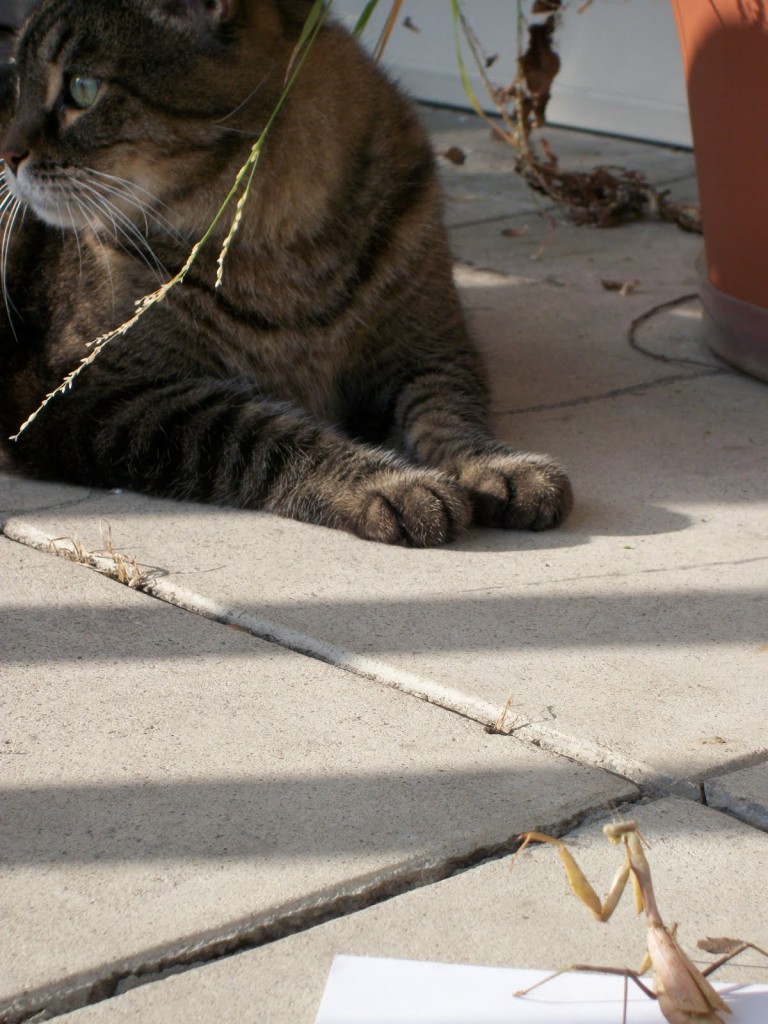Alex W. sent in a 1972 ad for Weyenberg Massagic shoes (a version of which was reprinted in Ms. magazine in 1974, after appearing in Playboy). The ad uses subtle imagery and text to imply that if men buy the right footwear, women will be so entranced that they will remain in their natural habitat, the floor (more specifically, as reader Jamie points out, at your feet), just for the chance to gaze at the beautiful product:
gender
Philip Cohen, at Family Inequality, posted an interesting graph displaying 30-44-year-old women’s share of their household’s income by level of education:

The graph shows that, on average, women with higher levels of education have incomes closer to that of their husbands than women with lower levels of education. Cohen writes:
It captures nicely both how women’s earning power within married couples has increased, and how that shift has been much greater for women with higher education.
In other words, the figure suggests that efforts to close the wage gap between men and women have been much more successful at the top of the economic ladder than the bottom.
Lisa Wade, PhD is an Associate Professor at Tulane University. She is the author of American Hookup, a book about college sexual culture; a textbook about gender; and a forthcoming introductory text: Terrible Magnificent Sociology. You can follow her on Twitter and Instagram.
Abby Kinchy, Assistant Professor at Rensselaer Polytechnic Institute, Richard M., and Alana B., who blogs at Pecan Pie, sent us a link to a post by Maya at Feministing about an anti-domestic violence PSA from South Africa. The group that created the ad, People Opposing Women Abuse, set up an experiment of sorts. A man first played drums loudly in his townhouse, quickly leading to multiple complaints by neighbors about the noise and a written warning. On a different night, the group loudly played a tape of what sounded like a violent dispute between a man and a woman. The reaction? Watch:
Aside from the obviously horrifying implications about domestic violence, I think it’s an interesting illustration of what people feel comfortable intervening or complaining about. As Maya points out in the original post, we all like to think we would immediately be at the door or on the phone with police, but many of us have, at one point or another, encountered a situation where we didn’t know whether to intervene or not:
…I once sat in a subway station in Manhattan late at night and watched a man try to get a sobbing, drunk woman to leave with him. I hesitated, not sure what to do. A few minutes later the police arrived; someone had acted, but it wasn’t me. Just last week, I saw a man aggressively slap a woman’s butt as she walked past in my neighborhood. I looked the other way, and she didn’t say anything either. I ignore sexual harassment—directed at me or others—pretty much every day.
I suspect what is going on here is a mixture of factors: that we put violence between partners into a different, less serious category than, say, a fist-fight between strangers at a bar, an unwillingness to intervene in what many think of as a private family matter, and fear about our own safety if we get involved or call authorities, among others.
For a thorough discussion of the so-called “bystander effect,” and the complex reasons people may not report behavior they find inappropriate, check out this article (free of charge) from the Journal of the International Ombudsmen Association.
Both Linda Jay and a colleague of mine, Dr. Caroline Heldman, drew my attention to the new Minnie Mouse-themed line at Forever 21. The line is a collaboration between Disney and the fashion outlet and the mouse has been re-modeled, so to speak.
What must one do to Minnie to make her an acceptable fashion icon? Starve her down to a stick figure, apparently.

Lisa Wade, PhD is an Associate Professor at Tulane University. She is the author of American Hookup, a book about college sexual culture; a textbook about gender; and a forthcoming introductory text: Terrible Magnificent Sociology. You can follow her on Twitter and Instagram.
Advertisers have mystified chocolate, portraying it as an intoxicant possessing the power to comfort, reward and satisfy women’s sexual desires. In doing so, these ads instruct the viewer to frame and interpret their own chocolate cravings in ways that overcome any resistance to consuming it.
To begin, consider this commercial for Dove:
Consider, also, this ad for Ferrero Rocher:
In particular, advertisers portray chocolate as satisfying female sexual desires. Such advertisements lead female viewers to understand their own desire for chocolate as a natural expression of their sexy femininity. The association of chocolate with luxury and the upper classes renders this sexuality socially acceptable. The symbolic sex is not that of the “crude lower class,” but the refined upper-class.
Text:
NOW IT CAN last longer THAN YOU CAN resist.
UNWRAP. INDULGE. REPEAT.
The misconception that chocolate is an aphrodisiac is exploited by these advertisements. The idea that chocolate contains chemicals that are similar to the mild-altering components found in ecstasy and marijuana, and evoke a feeling similar to falling in love, is now widespread. In actuality, studies have found that the amounts of these mood-enhancing chemicals are at such a low level that it is unlikely they lead to the euphoria that some feel when they consume chocolate. The findings of what could be called “chocolate propaganda research,” then, are negligible. Yet, marketing continues to perpetuate chocolate’s association with love and sex and its implied special relevance to women.
The association is so ubiquitous that it was mocked in an Axe commercial. Screenshot:
So why the insistence on indulgence?
Chocolate marketing must overcome the chief factor inhibiting women’s consumption: the fact that consumption of a fat, sweet food is inherently taboo for women, who are supposed to watch their weight. As a result, advertisers have replaced this food taboo with a sexual one. They have turned chocolate into a sexual, self-indulgent, private experience that invokes a taboo similar to that of masturbation. The intent is to equip her with an automatic inner-response to overcome her moment of self-restraint: the belief that chocolate consumption represents and enhances her femininity via satisfying her sexually, but tastefully, of course. Advertisers, then, overcome viewer resistance by shaping how they interpret and frame their own desires.
————————–
Jamal Fahim graduated from Occidental College in 2010 with a major in Sociology and a minor in Film and Media Studies. He was a member and captain of the Occidental Men’s Tennis team. After he graduated, Jamal moved from San Francisco to Los Angeles with the intention of working in the film industry as a producer. His interests include film, music, digital design, anime, Japanese culture, improvising, acting, and of course, chocolate!
If you would like to write a post for Sociological Images, please see our Guidelines for Guest Bloggers.
Cross-posted at Jezebel.
A new report from the Centers for Disease Control (via Family Inequality) reveals that boys report less sex education than girls.
What teenagers report learning from school:

What teenagers report learning from their parents:

Compared to boys, then, girls report more guidance from school and significantly more from their parents. This probably reflects cultural ideas that boys naturally desire sex, have a positive sense of their own sexuality, and that nothing really bad can happen to them; in contrast, the risk that sex poses to girls’ reputations and the possibility of sexual violence and pregnancy often shape how educators and parents manage their emerging sexualities.
Or it might be an artifact of self-reporting. Thoughts?
See also our popular post on STI, pregnancy, and abortion rates in the U.S. versus select European countries (hint: the U.S. doesn’t come out smelling like roses).
Lisa Wade, PhD is an Associate Professor at Tulane University. She is the author of American Hookup, a book about college sexual culture; a textbook about gender; and a forthcoming introductory text: Terrible Magnificent Sociology. You can follow her on Twitter and Instagram.
Cross-posted at Ms. and Jezebel.
Bug lovers will recall that the female praying mantis cannibalizes the head of her sexual partner upon mating. Wrote Leland Ossian Howard in Science (1886):
Placing them in the same jar, the male, in alarm, endeavoured to escape. In a few minutes the female succeeded in grasping him. She first bit off his front tarsus, and consumed the tibia and femur. Next she gnawed out his left eye… it seems to be only by accident that a male ever escapes alive from the embraces of his partner.
The idea that the female mantis is a femme fatale has resonated in U.S. culture, a culture that loves to recount how human women kill the spirits of their male mates; a culture that, as Twisty Faster puts it, “…will unfairly characterize females as villains whenever possible.”
Well, it turns out that our perfect icon of the man-killer was partly an artifact of bad research design. Faster, who blogs at I Blame the Patriarchy, reports that the study that established that female mantises decapitate their mates used starving females. A new study has documented an entirely different mating ritual:
Out of thirty matings, we didn’t record one instance of cannibalism, and instead we saw an elaborate courtship display, with both sexes performing a ritual dance, stroking each other with their antennae before finally mating. It really was a lovely display.
Well, except:
There is one species…. the Mantis religiosa, in which it is necessary that the head be removed for the mating to take effect properly. [In general, though, s]exual cannibalism occurs most often if the female is hungry. But eating the head does causes the body to ejaculate faster.
One species, okay, but there are over 2,000 species of praying mantis. (You learn something every day.) In any case, everyone loves a good bad-woman story and I suppose that one was just too good to pass up.
I have to admit, though, they are still bad motherf—ers. This mantis boxed my cat into a corner:
Also in projecting human relations onto animals: winners and losers of flatworm sex.
Lisa Wade, PhD is an Associate Professor at Tulane University. She is the author of American Hookup, a book about college sexual culture; a textbook about gender; and a forthcoming introductory text: Terrible Magnificent Sociology. You can follow her on Twitter and Instagram.
These vintage Lucky Strike cigarette ads posted at the Stanford School of Medicine collection tell both women and men that they can lose weight if they reach for a smoke instead of a sweet





I’ve never seen any contemporary cigarette advertising using this idea to sell to men; but we have and do see the “slims” meme in advertising cigarettes to women.
Lisa Wade, PhD is an Associate Professor at Tulane University. She is the author of American Hookup, a book about college sexual culture; a textbook about gender; and a forthcoming introductory text: Terrible Magnificent Sociology. You can follow her on Twitter and Instagram.
Philip Cohen, at Family Inequality, posted an interesting graph displaying 30-44-year-old women’s share of their household’s income by level of education:

The graph shows that, on average, women with higher levels of education have incomes closer to that of their husbands than women with lower levels of education. Cohen writes:
It captures nicely both how women’s earning power within married couples has increased, and how that shift has been much greater for women with higher education.
In other words, the figure suggests that efforts to close the wage gap between men and women have been much more successful at the top of the economic ladder than the bottom.
Lisa Wade, PhD is an Associate Professor at Tulane University. She is the author of American Hookup, a book about college sexual culture; a textbook about gender; and a forthcoming introductory text: Terrible Magnificent Sociology. You can follow her on Twitter and Instagram.
Abby Kinchy, Assistant Professor at Rensselaer Polytechnic Institute, Richard M., and Alana B., who blogs at Pecan Pie, sent us a link to a post by Maya at Feministing about an anti-domestic violence PSA from South Africa. The group that created the ad, People Opposing Women Abuse, set up an experiment of sorts. A man first played drums loudly in his townhouse, quickly leading to multiple complaints by neighbors about the noise and a written warning. On a different night, the group loudly played a tape of what sounded like a violent dispute between a man and a woman. The reaction? Watch:
Aside from the obviously horrifying implications about domestic violence, I think it’s an interesting illustration of what people feel comfortable intervening or complaining about. As Maya points out in the original post, we all like to think we would immediately be at the door or on the phone with police, but many of us have, at one point or another, encountered a situation where we didn’t know whether to intervene or not:
…I once sat in a subway station in Manhattan late at night and watched a man try to get a sobbing, drunk woman to leave with him. I hesitated, not sure what to do. A few minutes later the police arrived; someone had acted, but it wasn’t me. Just last week, I saw a man aggressively slap a woman’s butt as she walked past in my neighborhood. I looked the other way, and she didn’t say anything either. I ignore sexual harassment—directed at me or others—pretty much every day.
I suspect what is going on here is a mixture of factors: that we put violence between partners into a different, less serious category than, say, a fist-fight between strangers at a bar, an unwillingness to intervene in what many think of as a private family matter, and fear about our own safety if we get involved or call authorities, among others.
For a thorough discussion of the so-called “bystander effect,” and the complex reasons people may not report behavior they find inappropriate, check out this article (free of charge) from the Journal of the International Ombudsmen Association.
Both Linda Jay and a colleague of mine, Dr. Caroline Heldman, drew my attention to the new Minnie Mouse-themed line at Forever 21. The line is a collaboration between Disney and the fashion outlet and the mouse has been re-modeled, so to speak.
What must one do to Minnie to make her an acceptable fashion icon? Starve her down to a stick figure, apparently.

Lisa Wade, PhD is an Associate Professor at Tulane University. She is the author of American Hookup, a book about college sexual culture; a textbook about gender; and a forthcoming introductory text: Terrible Magnificent Sociology. You can follow her on Twitter and Instagram.
Advertisers have mystified chocolate, portraying it as an intoxicant possessing the power to comfort, reward and satisfy women’s sexual desires. In doing so, these ads instruct the viewer to frame and interpret their own chocolate cravings in ways that overcome any resistance to consuming it.
To begin, consider this commercial for Dove:
Consider, also, this ad for Ferrero Rocher:
In particular, advertisers portray chocolate as satisfying female sexual desires. Such advertisements lead female viewers to understand their own desire for chocolate as a natural expression of their sexy femininity. The association of chocolate with luxury and the upper classes renders this sexuality socially acceptable. The symbolic sex is not that of the “crude lower class,” but the refined upper-class.
Text:
NOW IT CAN last longer THAN YOU CAN resist.
UNWRAP. INDULGE. REPEAT.
The misconception that chocolate is an aphrodisiac is exploited by these advertisements. The idea that chocolate contains chemicals that are similar to the mild-altering components found in ecstasy and marijuana, and evoke a feeling similar to falling in love, is now widespread. In actuality, studies have found that the amounts of these mood-enhancing chemicals are at such a low level that it is unlikely they lead to the euphoria that some feel when they consume chocolate. The findings of what could be called “chocolate propaganda research,” then, are negligible. Yet, marketing continues to perpetuate chocolate’s association with love and sex and its implied special relevance to women.
The association is so ubiquitous that it was mocked in an Axe commercial. Screenshot:
So why the insistence on indulgence?
Chocolate marketing must overcome the chief factor inhibiting women’s consumption: the fact that consumption of a fat, sweet food is inherently taboo for women, who are supposed to watch their weight. As a result, advertisers have replaced this food taboo with a sexual one. They have turned chocolate into a sexual, self-indulgent, private experience that invokes a taboo similar to that of masturbation. The intent is to equip her with an automatic inner-response to overcome her moment of self-restraint: the belief that chocolate consumption represents and enhances her femininity via satisfying her sexually, but tastefully, of course. Advertisers, then, overcome viewer resistance by shaping how they interpret and frame their own desires.
————————–
Jamal Fahim graduated from Occidental College in 2010 with a major in Sociology and a minor in Film and Media Studies. He was a member and captain of the Occidental Men’s Tennis team. After he graduated, Jamal moved from San Francisco to Los Angeles with the intention of working in the film industry as a producer. His interests include film, music, digital design, anime, Japanese culture, improvising, acting, and of course, chocolate!
If you would like to write a post for Sociological Images, please see our Guidelines for Guest Bloggers.
Cross-posted at Jezebel.
A new report from the Centers for Disease Control (via Family Inequality) reveals that boys report less sex education than girls.
What teenagers report learning from school:

What teenagers report learning from their parents:

Compared to boys, then, girls report more guidance from school and significantly more from their parents. This probably reflects cultural ideas that boys naturally desire sex, have a positive sense of their own sexuality, and that nothing really bad can happen to them; in contrast, the risk that sex poses to girls’ reputations and the possibility of sexual violence and pregnancy often shape how educators and parents manage their emerging sexualities.
Or it might be an artifact of self-reporting. Thoughts?
See also our popular post on STI, pregnancy, and abortion rates in the U.S. versus select European countries (hint: the U.S. doesn’t come out smelling like roses).
Lisa Wade, PhD is an Associate Professor at Tulane University. She is the author of American Hookup, a book about college sexual culture; a textbook about gender; and a forthcoming introductory text: Terrible Magnificent Sociology. You can follow her on Twitter and Instagram.
Cross-posted at Ms. and Jezebel.
Bug lovers will recall that the female praying mantis cannibalizes the head of her sexual partner upon mating. Wrote Leland Ossian Howard in Science (1886):
Placing them in the same jar, the male, in alarm, endeavoured to escape. In a few minutes the female succeeded in grasping him. She first bit off his front tarsus, and consumed the tibia and femur. Next she gnawed out his left eye… it seems to be only by accident that a male ever escapes alive from the embraces of his partner.
The idea that the female mantis is a femme fatale has resonated in U.S. culture, a culture that loves to recount how human women kill the spirits of their male mates; a culture that, as Twisty Faster puts it, “…will unfairly characterize females as villains whenever possible.”
Well, it turns out that our perfect icon of the man-killer was partly an artifact of bad research design. Faster, who blogs at I Blame the Patriarchy, reports that the study that established that female mantises decapitate their mates used starving females. A new study has documented an entirely different mating ritual:
Out of thirty matings, we didn’t record one instance of cannibalism, and instead we saw an elaborate courtship display, with both sexes performing a ritual dance, stroking each other with their antennae before finally mating. It really was a lovely display.
Well, except:
There is one species…. the Mantis religiosa, in which it is necessary that the head be removed for the mating to take effect properly. [In general, though, s]exual cannibalism occurs most often if the female is hungry. But eating the head does causes the body to ejaculate faster.
One species, okay, but there are over 2,000 species of praying mantis. (You learn something every day.) In any case, everyone loves a good bad-woman story and I suppose that one was just too good to pass up.
I have to admit, though, they are still bad motherf—ers. This mantis boxed my cat into a corner:
Also in projecting human relations onto animals: winners and losers of flatworm sex.
Lisa Wade, PhD is an Associate Professor at Tulane University. She is the author of American Hookup, a book about college sexual culture; a textbook about gender; and a forthcoming introductory text: Terrible Magnificent Sociology. You can follow her on Twitter and Instagram.
These vintage Lucky Strike cigarette ads posted at the Stanford School of Medicine collection tell both women and men that they can lose weight if they reach for a smoke instead of a sweet





I’ve never seen any contemporary cigarette advertising using this idea to sell to men; but we have and do see the “slims” meme in advertising cigarettes to women.
Lisa Wade, PhD is an Associate Professor at Tulane University. She is the author of American Hookup, a book about college sexual culture; a textbook about gender; and a forthcoming introductory text: Terrible Magnificent Sociology. You can follow her on Twitter and Instagram.








